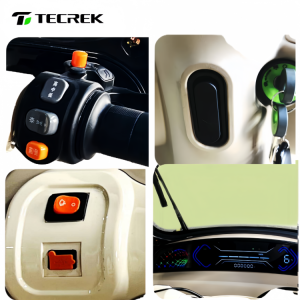Введение
В последние годы технология Brake-by-Wire Низкоскоростные и автономные транспортные средства Появилась ключевым фактором для более умной и безопасной мобильности. Как низкоскоростные транспортные средства (LSV) В то время как автономные транспортные платформы распространяются в городских, кампусных и промышленных условиях, традиционные механические тормозные системы сталкиваются с ограничениями в точности управления, интеграции и восстановлении энергии. В этой статье рассказывается о том, как системы Brake-by-Wire (BBW) революционизируют тормозование в этих контекстах, освещаются ключевые технологические пути, рассматриваются проблемы и прогнозируются, как эта эволюция может изменить будущую мобильность.

I. Почему Brake-by-Wire имеет значение в Низкие скорости & Автономная мобильность
1.1 Необходимость усовершенствования контроля торможения
С ростом автономных и полуавтономных низкоскоростные транспортные средства, тормозные требования смены. В сложных условиях - тесных поворотов, переменных дорожных поверхностей, пешеходных зон - традиционные механические или гидравлические тормоза могут отставать в реагировании. Технология Brake-by-Wire для Низкоскоростные и автономные транспортные средства Paradigm предлагает более тонкое, быстрое и адаптивное управление, что имеет решающее значение для безопасности и комфорта езды.
1.2 Интеграция с автономией и Электронное шасси
Современные ЛСВ все более интегрировать электронное управление через рулевое управление, дроссель и подвеску. Brake-by-Wire легко соответствует этой архитектуре: электронный тормозный интерфейс (а не механическая связь) позволяет тормозной системе координироваться с логикой автономного вождения, управлением стабильностью, антиблокирующими системами (ABS) и регенеративным тормозом. Оцениваемый ЛСВБумага BBW подчеркивает эту конвергенцию как путь к более эффективному и целостному контролю.
1.3 Энергоэффективность и Регенеративные синергии
Одним из преимуществ BBW является более точная модуляция давления на колесо, которая более эффективно поддерживает регенеративное торможение. Координируя трение и регенерацию, система Brake-by-Wire для низкоскоростных и автономных транспортных средств максимизирует восстановление энергии без ущерба для тормозной эффективности. В низкоскоростных сценариях остановки и поездки, общих для ЛСВ использование, эта синергия способствует повышению эффективности.
II. Основные архитектуры: электро-гидравлическая vs электро-механическая
2.1 Электрогидравлические тормозные системы (EHB)
Архитектура EHB является гибридной: она заменяет вакуумный усилитель в традиционной гидравлической тормозной цепочке электронным приводом, сохраняя при этом гидравлические линии. Это делает EHB переходным решением. Согласно обзору, EHB остается доминирующим вариантом BBW в исследованиях LSV из-за совместимости с существующей гидравлической инфраструктурой и более безопасными резервными режимами.
Типичные системы EHB включают в себя такие компоненты, как клапан симулятора педали, управляющий ЭКУ, гидравлический привод и клапаны безопасности/защиты от сбоев. Стратегии управления часто используют PID, нечеткую логику или контроллеры отказа от нарушений для точного регулирования давления на колеса. В обзоре указывается, что конструкции EHB должны тщательно управлять динамикой давления, приведением в действие электромагнитного клапана и избыточными путями безопасности.
2.2 Электромеханические тормозные системы (EMB)
Напротив, системы EMB полностью устраняют гидравлические жидкости, используя приводные приводы двигателя (например, винты, передачи или электромагнитные системы) для непосредственного применения тормозной силы. Как уточняется в обзоре BBW, EMB обещает снизить вес системы, модульную конструкцию, устранение утечки жидкости и более тесную интеграцию с электронными системами управления.
Однако EMB сталкивается с препятствиями: обеспечение достаточной силы зажима, надежности, времени реакции, избыточности в случае сбоя и нормативного принятия. В обзоре отмечается, что EMB в ЛСВ применение еще не зрело в коммерческом плане, но является ключевым направлением для будущих тормозных инноваций.
2.3 Стратегии допустимости к ошибкам, избыточности и контроля
Будь то EHB или EMB, безопасность и надежность имеют первостепенное значение. В обзоре посвящен раздел диагностике неисправностей, резервности (например, двойные или тройные резервные модули), смягчению сбоев датчиков и резервным режимам. Надежные стратегии управления (скользящие режимы, адаптивные наблюдатели, неисправное управление) необходимы для того, чтобы сделать BBW жизнеспособным для реального мира ЛСВ развертывание.
III. Проблемы, ограничения и Пробелы в исследованиях
3.1 Сертификация безопасности и нормативные препятствия
Одним из основных препятствий является то, что системы EMB/BBW должны соответствовать строгим сертификатам безопасности, особенно для использования на дорогах. Регуляторы осторожны при полной замене механических или гидравлических связей. Для ЛСВ и автономные шаттлы для использования технологии тормоза по проводу для низкоскоростных и автономных транспортных средств, требуются обширные режимы проверки, избыточности и безопасности от сбоев.
3.2 Надежность в условиях экологического стресса Старение
Электронные компоненты, проводки, приводы и датчики должны выдерживать изменения температуры, влажность, износ и потенциальные неисправности. Обеспечение последовательной тормозной эффективности в течение всего жизненного цикла не является тривиальным. В обзорной статье подчеркивается необходимость надежных алгоритмов, терпимых к ошибкам, избыточного оборудования и стратегий самодиагностики.
3.3 Стоимость, сложность и Интеграция
По сравнению с обычными тормозами системы BBW приводят дополнительные затраты (приводы, датчики, ЭКУ) и сложность программного обеспечения. Интеграция с существующими платформами транспортных средств, масштабирование по объему и управление обслуживанием или ремонтом будут сложными задачами, особенно в тех случаях, когда речь идет о затратах. ЛСВ сегмент.
IV. Перспективы и Будущие направления
4.1 К полностью автономным тормозным системам
По мере зрелости автономного вождения торможение должно перейти от человеческого управления к полностью электронному управлению. Технология Brake-by-Wire для Низкоскоростные и автономные транспортные средства Скорее всего, это станет стандартом в геоогражденных автономных шаттлах, транспортных средствах кампуса и умных капсулах мобильности.
4.2 Коммерциализация EMB и гибридные архитектуры
Системы EMB будут постепенно созревать, начиная с контролируемых сред или закрытых схем. Гибридные подходы, сочетающие резервный механизм EHB для обеспечения безопасности с основным приводом EMB, могут служить переходными архитектурами.
4.3 Адаптивное тормозение на основе ИИ
Будущие системы BBW могут включать машинное обучение или прогнозное управление моделью для адаптации поведения торможения к условиям дороги, нагрузке транспортного средства и профилям водителя. Это повышает роль электронного управления в автономных тормозных системах транспортных средств.
4.4 Расширение практики использования LSV & Секторы микромобильности
По мере повышения стоимости, сертификации безопасности и доверия пользователей BBW может распространяться на различные формы микромобильности (соседство EVs, автономные корзины, шаттлы последней мили). Обзор показывает, что BBW является основой для интеллектуального, безопасного и эффективного ЛСВ экосистем.
Вывод
В настоящее время многочисленные предприятия, в том числе Тайруи ГруппаЭнергично развиваются Новое энергетическое малоскоростное транспортное средствосТехнология Brake-by-Wire для Низкоскоростные и автономные транспортные средства поле представляет собой ключевую эволюцию в системах управления транспортным средством, особенно для нового класса ЛСВ Автономные платформы микромобильности. Повышая точность управления, обеспечивая более сильную интеграцию с автономией и улучшая восстановление энергии, BBW превращает торможение из механической функции в оркестрированную электронную подсистему. Проблемы остаются - в плане безопасности, стоимости, надежности - но продолжающиеся исследования, более богатые конструкции, устойчивые к ошибкам, и нормативное согласование могут привести это видение в реальный мир. По мере изменения ландшафта мобильности транспортные средства, использующие передовые системы BBW, могут стать авангардом следующего поколения интеллектуального и эффективного транспорта.
